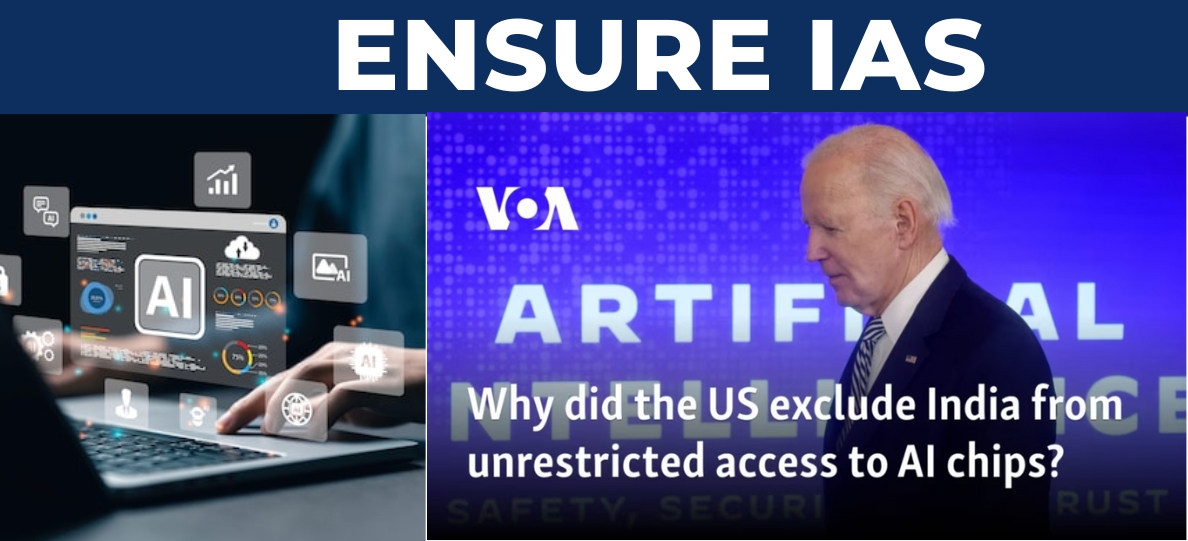- Courses
- GS Full Course 1 Year
- GS Full Course 2 Year
- GS Full Course 3 Year
- GS Full Course Till Selection
- Answer Alpha: Mains 2025 Mentorship
- MEP (Mains Enrichment Programme) Data, Facts
- Essay Target – 150+ Marks
- Online Program
- GS Recorded Course
- Polity
- Geography
- Economy
- Ancient, Medieval and Art & Culture AMAC
- Modern India, Post Independence & World History
- Environment
- Governance
- Science & Technology
- International Relations and Internal Security
- Disaster Management
- Ethics
- NCERT Current Affairs
- Indian Society and Social Issue
- NCERT- Science and Technology
- NCERT - Geography
- NCERT - Ancient History
- NCERT- World History
- NCERT Modern History
- CSAT
- 5 LAYERED ARJUNA Mentorship
- Public Administration Optional
- ABOUT US
- OUR TOPPERS
- TEST SERIES
- FREE STUDY MATERIAL
- VIDEOS
- CONTACT US
US AI Export Rule Excludes India from Benefits of Closest Allies: What Could the Impact Be?
US AI Export Rule Excludes India from Benefits of Closest Allies: What Could the Impact Be?
16-01-2025

- In January 2025, just before leaving office, the Joe Biden administration introduced an expansive AI export regulation that could affect India’s ambitions in artificial intelligence (AI).
- The US government published an "interim final rule" called "Framework for Artificial Intelligence Diffusion," creating a 3-tier system to regulate the export of advanced AI hardware like graphics processing units (GPUs).
- India finds itself in the middle tier, facing some restrictions on importing these essential AI chips.
- The new rules could have a far-reaching impact on India's efforts to boost its AI capabilities.
What are the Three Tiers of Countries for AI Exports?
The new rules divide countries into three categories, each with different levels of access to US AI technology:
Tier 1: US's Closest Allies (No Major Restrictions)
- The first tier includes 18 of the closest allies of the United States, such as:
-
- Australia
- Belgium
- Canada
- Denmark
- France
- Germany
- Ireland
- Italy
- Japan
- South Korea
- Spain
- Sweden
- Taiwan
- United Kingdom
- Countries in Tier 1 can access AI chips and other computing hardware with virtually no restrictions.
- These countries can import unlimited advanced AI technology from the US, and there are simplified security protocols for these nations.
- This gives them a major advantage in advancing their AI technologies and using advanced computing resources.
Tier 2: Most Countries, Including India (Moderate Restrictions)
- Tier 2 consists of the majority of countries worldwide, including India.
- Countries in this tier will face limitations on the amount of AI chips they can import from the US.
- These limitations are designed to control the spread of advanced technology to countries that are not considered close allies.
- India, for instance, is attempting to procure 10,000 GPUs as part of its IndiaAI Mission to develop its AI infrastructure. However, these new rules could delay or restrict its efforts.
- Tier 2 countries can import approximately 50,000 advanced AI chips through 2027, though this number can be increased if the country reaches a special agreement with the US.
- The rules state that AI hardware imports to these countries will only be allowed if it is used in trusted and secure environments, such as AI research labs or data centers built with high security.
- This tier could significantly impact India’s AI strategy.
- It could complicate the expansion of AI data centers and potentially slow down large-scale AI projects.
- However, smaller firms or those without big data center plans may face fewer issues.
Tier 3: Countries of Concern (Almost No Exports)
- The third tier includes countries that the US considers a national security risk.
- These countries, such as China, Russia, North Korea, and Libya, will face near-total restrictions on accessing advanced US technology.
- These countries will have little to no access to AI chips or other advanced technology under these rules, which are intended to limit the spread of critical technologies to potentially hostile nations.
What are the Special Provisions for India and China?
- In addition to the tier system, there is a special review process called the General Validated End User (GVEU) list.
- Both India and China are on this list, meaning they have a special status when it comes to using US technology:
- Indian companies that receive GVEU authorization can use the exported AI hardware for both civilian and military purposes, but not for nuclear applications.
- Chinese companies that get GVEU authorization can only use the technology for civilian purposes. This distinction reflects US concerns over China’s military applications of American technology.
- This special provision gives India an advantage over other countries in Tier 2, but the restrictions still limit India’s access to the full potential of US AI technology.
What is Impact on India’s AI Ambitions?
- India is working hard to develop its AI infrastructure to compete in the global AI race.
- With projects like the IndiaAI Mission, India has big plans to build up its AI capabilities.
- However, these new US export rules could present major obstacles:
- India’s goal of acquiring 10,000 GPUs could face delays as the rules restrict the number of AI chips India can import from the US.
- These limits could affect the development of AI data centers that are essential for large-scale AI research and applications.
- India’s smaller companies, especially those not involved in large AI projects, may be less affected by these restrictions.
- Despite these challenges, the US and India could negotiate special agreements to increase the amount of AI hardware available to India, potentially boosting the AI sector.
Why Is Nvidia Criticizing the New Rules?
- Nvidia, the leading supplier of GPUs for AI applications, has criticized the new AI export rules.
- Some of their concerns:
- Nvidia believes the Biden administration is limiting the US’s global leadership in the AI sector with this expansive regulatory framework.
- The company argues that the US tech industry needs to remain competitive globally and that these regulations could undermine innovation by making it harder for US companies to sell their products in foreign markets.
- Nvidia contrasts the Biden administration's approach with that of the Trump administration, which promoted an environment where US industries could thrive without strict restrictions while still protecting national security.
- Nvidia warns that these rules could weaken US competitiveness and ultimately harm AI innovation in the long term.
Conclusion
As India tries to procure 10,000 GPUs for its IndiaAI Mission, these regulations could complicate efforts to build AI data centers and conduct large-scale AI research. While India has the advantage of being included in the General Validated End User (GVEU) list, allowing access to US technology for both civilian and military uses, the overall impact of these rules will depend on future negotiations with the US and any potential special agreements that may allow India to increase its access to advanced AI technology.
|
Also Read |
|
UPSC Foundation Course |
|
| CSAT Foundation Course | |




